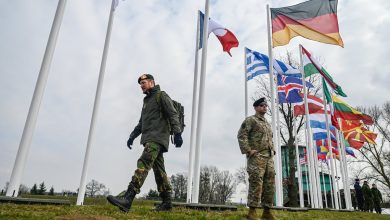Eurofighter vendor targets ‘combat mass’ over next-gen buzz

PARIS — The companies behind the Eurofighter, Europe’s most prevalent homegrown combat jet, have set new growth targets that prize a near-term fleet buildup over more distant breakthroughs expected from sixth-generation programs like the Future Combat Air System, or FCAS.
The plan envisions an annual Eurofighter production boost from 14 planes now to 20 copies within 36 months, eying 30 at some point after that, said Jorge Tamarit Degenhardt, CEO of a consortium combining Airbus, Leonardo and BAE Systems.
Degenhardt told reporters at the Paris Air Show he expects the export business to grow, with sales campaigns humming in Turkey, Saudi Arabia, Poland, Austria and Portugal. That is in addition to requests for planes and upgrades from the core users Germany, Spain, Italy and the United Kingdom.
“We didn’t max out yet,” Degenhardt said, referring to company plans to make more jets, faster.
The idea of producing “combat mass” for Europe, as the CEO called it, follows the urgency of recent conflicts sprung on the continent and its environs, most notably Russia’s war against Ukraine.
In that logic, a large fleet of warplanes of the generation 4-plus, which means capable but not stealthy, for example, is better than a futuristic airpower weapon that exists only on paper.
For now, Eurofighter officials are pitching to client nations a mid-life upgrade program aimed at modernizing the jet’s computing power and other basic features. Integrating drone buddies with the manned planes is also under consideration.
Asked about a price tag, Degenhardt demurred, saying only the envisioned technology upgrades are essential to keep the fleet viable.
“Jets delivered today will fly into the 2060s,” he said.
France and Germany are leading the sixth-generation FCAS program meant to produce a brand new warplane-drone mixture sometime in the 2040s.
That approximate target date appears to have become more squishy, as nations absorb lessons in combat adaption from Ukraine that are measured in days, weeks or months – not decades.
As a result, talk at Paris Air Show about FCAS took a more distant, aspirational tone, compared to the premise of a European rallying cry for all things air power under which it began.
A similar trend is playing out in France, where national warplane champion Dassault has eyes mostly on its own Rafale jet development and upcoming drone accoutrements.
The company is looking to extend the operational lifespan of the Rafale by at least two more decades and is currently preparing the next F5 standard upgrade for the fighter, which will add improved connectivity to integrate with other systems and the possibility to team up with a stealthy unmanned wingman drone.
Dassault Aviation CEO Eric Trappier has said the Rafale F5 standard is expected in the 2030-2035 window, with ongoing improvements to the existing aircraft in the coming ten years with partners Thales and Safran, with a focus on networking and connectivity.
The company last year was tasked by France’s Directorate General for Armament to develop the stealthy wingman based on its nEUROn demonstrator, operating ahead of the Rafale and controlled by the pilot of the manned aircraft.
Trappier told a parliamentary committee in April that the next-generation fighter is for the 2040s and beyond, and more likely 2045, with the Rafale and the future aircraft operating side by side for a period of time. Dassault representatives at the air show this week confirmed that schedule of the Rafale F5 standard bridging the 2035-2045 gap.
Meanwhile, FCAS partner Airbus said the goal for the Next Generation Weapons System remains to deliver capabilities to the three partner nations by 2040, and Jean-Brice Dumont, the company’s head of air power, told reporters in a press conference at the air show on Tuesday he had “no breaking news” on the project.
He said phase 1B of the program had “clearly” observed difficulties in execution, and the partners have to accelerate.
Trappier told lawmakers in his April hearing that working with Airbus is “very, very difficult” amid continued bickering over work share.
Dumont said his company is not challenging Dassault Aviation’s role as the appointed leader of the fighter development within the wider program. He said the issue of work share should be treated in “a rather soft manner” to avoid it becoming toxic in the program.
“We today have to protect our intellectual property and tomorrow we will have to share everything, and I believe that’s one of the sources of tensions in this program,” Dumont said. “Maybe some elements of work share may have to be changed to make the program executable.”
The Airbus executive said what is needed now to make FCAS happen is political will and an agreed joint operational need.
“These programs come like the whole foundation of Airbus, like many of the many of the European projects, they come because there is a political will,” Dumont said. “The political will has to be there, otherwise it doesn’t happen.”
Sebastian Sprenger is associate editor for Europe at Defense News, reporting on the state of the defense market in the region, and on U.S.-Europe cooperation and multi-national investments in defense and global security. Previously he served as managing editor for Defense News. He is based in Cologne, Germany.
Rudy Ruitenberg is a Europe correspondent for Defense News. He started his career at Bloomberg News and has experience reporting on technology, commodity markets and politics.







